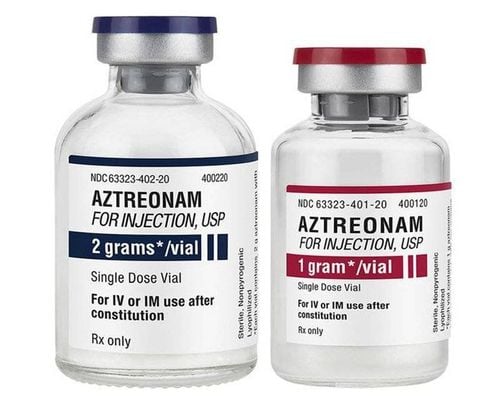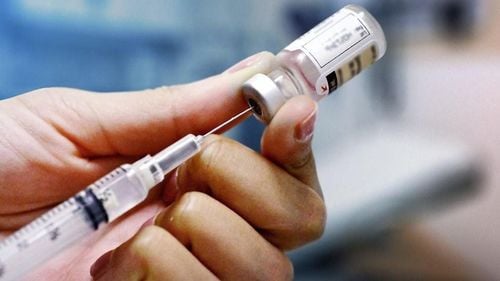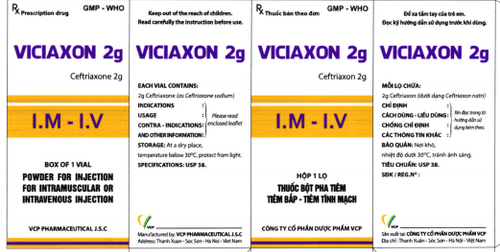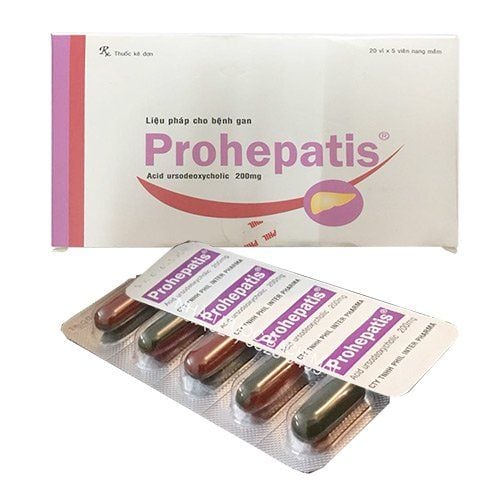This is an automatically translated article.
Gentawel medicine is prepared in the form of an injection solution, with the main ingredient being Gentamicin. It is used to treat some serious systemic infections.
1. What is Gentawel?
Each ampoule of Gentawel 2ml contains 159.521 mg Gentamicin sulfate BP (equivalent to Gentamicin 80mg) and other excipients. Gentamicin sulfate is an antibiotic belonging to the aminoglycoside group, which has bactericidal effects thanks to its ability to inhibit bacterial protein synthesis. The bactericidal spectrum of Gentamicin includes gram-negative aerobic bacteria and staphylococci.
Indications for use of Gentawel in the following cases:
In combination with other antibiotics (beta-lactams) to treat some serious systemic infections caused by susceptible bacteria: Biliary tract infections (acute cholangitis, cholecystitis), infections in viscous mucus disease, endocarditis, brucellosis, bacteremia, meningitis, pneumonia, Listeria infection, skin infections (burns, ulcers), bone and joint infections, intra-abdominal infections (peritonitis), urinary tract infections (acute pyelonephritis); Prevention of infections during surgery and during treatment of immunocompromised patients and patients in the intensive care unit; Used together with other bactericidal agents to expand the spectrum of action and improve the therapeutic effect. Specifically, the combination of Gentamicin with Penicillin in the treatment of infections caused by enterococci and streptococci; in combination with 1 beta-lactam against blue pus bacilli; in combination with metronidazole or clindamycin in the treatment of diseases caused by a mixture of aerobic and anaerobic bacteria. Gentawel is contraindicated in patients who are allergic to Gentamicin and other aminoglycosides.
2. Usage and dosage of Gentawel
2.1. Administration The drug is administered intramuscularly or intravenously, usually intramuscularly. Gentawel should not be injected subcutaneously because of the risk of skin necrosis. When intramuscular injection is not possible, intermittent intravenous infusion may be used. In this case, it is recommended to mix Gentamicin with isotonic sodium chloride or glucose solutions at a ratio of 1 ml of infusion solution to 1 mg of gentamicin. The infusion time is from 30 to 60 minutes. For patients with normal renal function, the infusion should be administered every 8 hours. In patients with renal impairment, the interval between infusion times should be longer.
2.2. Dosage Adjust according to patient's condition and age. Specifically:
Adults: Use a dose of 3mg/kg/day, divided into 2-3 times intramuscularly; Children: 3mg/kg/day, divided into 3 intramuscular injections (1mg/kg every 8 hours); Patients with renal failure: It is necessary to adjust the dose of the drug, regularly monitor renal, vestibular and cochlear function. Also, serum drug levels should be checked if possible. Overdose: Because there is currently no specific antidote, when using Gentawel in overdose or toxic reaction, the patient will be treated symptomatically and supportively. The recommended treatments are: Hemodialysis or peritoneal dialysis (to remove aminoglycosides from the patient's blood); use of anticholinesterase agents, calcium salts, or artificial respiration (neuromuscular blockade leading to persistent muscle weakness, respiratory failure, or apnea that occurs with concomitant administration of 2 or more aminoglycosides).
3. Gentawel side effects
When using Gentawel, patients may experience some side effects such as:
Common: Neurotoxicity (dizziness, dizziness, ataxia), gait instability, ear toxicity irreversible, deafness, edema, nephrotoxicity, decreased Clcr; Uncommon: Acute renal failure (usually mild but sometimes with interstitial nephritis or tubular necrosis), neuromuscular blockade (may cause respiratory failure and muscle paralysis); conjunctival congestion and edema, retinal ischemia, anorexia, somnolence, dyspnoea, gastritis, enteritis, headache, nausea, vomiting, muscle cramps, increased salivation, decreased weight loss, convulsions, hypomagnesemia with prolonged treatment, antibiotic-associated colitis, blood disorders; Rare: Anaphylaxis, liver dysfunction (hyperbilirubinemia, elevated liver enzymes). When experiencing side effects of Gentawel, patients should inform their doctor to receive advice on appropriate management.
4. Be careful when using Gentawel
Some notes patients need to remember before and while taking Gentawel:
The drug is toxic to hearing organs and kidneys. This side effect often occurs in elderly patients, people with kidney failure, hearing disorders,...; Careful monitoring is recommended for patients treated with high-dose or long-term Gentawel; For children, the elderly and people with kidney failure, the dose should be reduced; Use Gentawel with caution if indicated in people with severe myasthenia gravis, Parkinson's disease or symptoms of muscle weakness; There is a risk of nephrotoxicity when Gentawel is used in people with hypotension, liver disease or women; Gentawel drug can be toxic to the fetus, so it is best not to use the drug for pregnant women; Use caution when using Gentawel in nursing mothers; Do not use Gentawel while driving or operating machinery.
5. Gentawel drug interactions
Some drug interactions of Gentawel include:
Concomitant use of Gentamicin (main ingredient of Gentawel) and nephrotoxic drugs (other aminoglycosides, vancomycin, cephalosporins), ototoxic drugs (ethacrynic acid, furosemide) may increase the risk of toxicity. This risk is also increased when Gentamicin is co-administered with neuromuscular blocking agents; Indomethacin may increase the plasma concentration of Gentamicin if used concomitantly; Co-administration of Gentawel with antiemetics such as dimenhydrinate may mask the first symptoms of vestibular toxicity; Gentawel may decrease the renal elimination of zalcitabine; Risk of severe hypocalcaemia may occur in patients receiving Gentawel and bisphosphonate; Gentamicin inhibits alpha-galactosidase activity. Therefore, Gentawel should not be used concurrently with agalsidase alpha and agalsidase beta, gallium nitrate, BCG vaccine, typhoid vaccine; Gentamicin systemic use can increase the effect of drugs: Carboplatin, Abobotulinumtoxin A, cyclosporin, colistimethat, galium nitrate, rima botulinum toxin B, onabotulinumtoxinA; The effect of Gentamicin may be enhanced by capreomycin, amphotericin B, cephalosporins, cisplatin, NSAIDs, loop diuretics, vancomycin; The effect of Gentamicin may be reduced by penicillins; Gentamicin is incompatible with heparin, furosemide, sodium bicarbonate and some parenteral nutrition solutions. Gentamicin reacts with alkaline pH preparations or drugs that are unstable at acidic pH; Gentamicin should not be mixed with other drugs in the same time pump or in the same infusion solution, do not administer the same intravenous line. When injecting Gentamicin with another beta-lactam, it is necessary to inject at different sites. During the course of taking Gentawel, if you experience any unusual side effects, the patient should notify the doctor soon. This will help doctors intervene early to handle some unpredictable problems, reducing the risk of harm to the patient's health.
Please dial HOTLINE for more information or register for an appointment HERE. Download MyVinmec app to make appointments faster and to manage your bookings easily.













